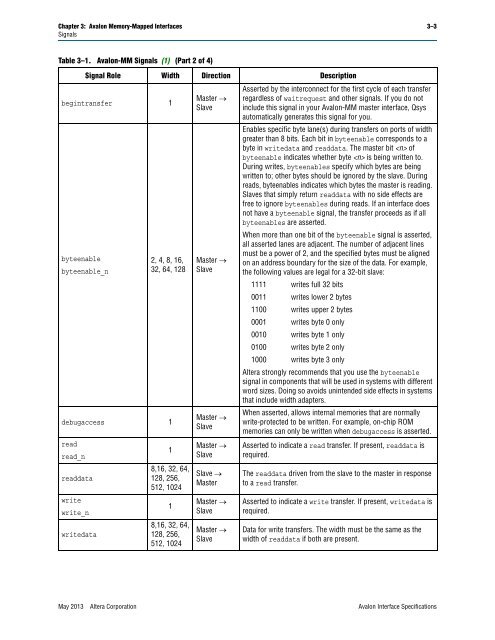Avalon Interface Specifications (PDF) - Altera
Avalon Interface Specifications (PDF) - Altera
Avalon Interface Specifications (PDF) - Altera
You also want an ePaper? Increase the reach of your titles
YUMPU automatically turns print PDFs into web optimized ePapers that Google loves.
Chapter 3: <strong>Avalon</strong> Memory-Mapped <strong>Interface</strong>s 3–3<br />
Signals<br />
Table 3–1. <strong>Avalon</strong>-MM Signals (1) (Part 2 of 4)<br />
begintransfer 1<br />
byteenable<br />
byteenable_n<br />
2, 4, 8, 16,<br />
32, 64, 128<br />
debugaccess 1<br />
read<br />
read_n<br />
readdata<br />
write<br />
write_n<br />
writedata<br />
Signal Role Width Direction Description<br />
1<br />
8,16, 32, 64,<br />
128, 256,<br />
512, 1024<br />
1<br />
8,16, 32, 64,<br />
128, 256,<br />
512, 1024<br />
Master →<br />
Slave<br />
Master →<br />
Slave<br />
Master →<br />
Slave<br />
Master →<br />
Slave<br />
Slave →<br />
Master<br />
Master →<br />
Slave<br />
Master →<br />
Slave<br />
Asserted by the interconnect for the first cycle of each transfer<br />
regardless of waitrequest and other signals. If you do not<br />
include this signal in your <strong>Avalon</strong>-MM master interface, Qsys<br />
automatically generates this signal for you.<br />
Enables specific byte lane(s) during transfers on ports of width<br />
greater than 8 bits. Each bit in byteenable corresponds to a<br />
byte in writedata and readdata. The master bit of<br />
byteenable indicates whether byte is being written to.<br />
During writes, byteenables specify which bytes are being<br />
written to; other bytes should be ignored by the slave. During<br />
reads, byteenables indicates which bytes the master is reading.<br />
Slaves that simply return readdata with no side effects are<br />
free to ignore byteenables during reads. If an interface does<br />
not have a byteenable signal, the transfer proceeds as if all<br />
byteenables are asserted.<br />
When more than one bit of the byteenable signal is asserted,<br />
all asserted lanes are adjacent. The number of adjacent lines<br />
must be a power of 2, and the specified bytes must be aligned<br />
on an address boundary for the size of the data. For example,<br />
the following values are legal for a 32-bit slave:<br />
1111 writes full 32 bits<br />
0011 writes lower 2 bytes<br />
1100 writes upper 2 bytes<br />
0001 writes byte 0 only<br />
0010 writes byte 1 only<br />
0100 writes byte 2 only<br />
1000 writes byte 3 only<br />
<strong>Altera</strong> strongly recommends that you use the byteenable<br />
signal in components that will be used in systems with different<br />
word sizes. Doing so avoids unintended side effects in systems<br />
that include width adapters.<br />
When asserted, allows internal memories that are normally<br />
write-protected to be written. For example, on-chip ROM<br />
memories can only be written when debugaccess is asserted.<br />
Asserted to indicate a read transfer. If present, readdata is<br />
required.<br />
The readdata driven from the slave to the master in response<br />
to a read transfer.<br />
Asserted to indicate a write transfer. If present, writedata is<br />
required.<br />
Data for write transfers. The width must be the same as the<br />
width of readdata if both are present.<br />
May 2013 <strong>Altera</strong> Corporation <strong>Avalon</strong> <strong>Interface</strong> <strong>Specifications</strong>
















